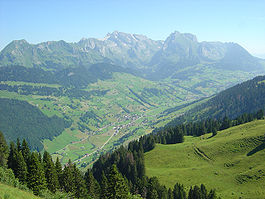Alt Sankt Johann
| Alt St. Johann | ||
|---|---|---|
| Former municipality of Switzerland | ||
 |
||
|
||
| Coordinates: 47°11′N 9°17′E / 47.183°N 9.283°ECoordinates: 47°11′N 9°17′E / 47.183°N 9.283°E | ||
| Country | Switzerland | |
| Canton | St. Gallen | |
| District | Toggenburg | |
| Government | ||
| • Mayor | Rolf Züllig | |
| Area | ||
| • Total | 53.10 km2 (20.50 sq mi) | |
| Elevation | 895 m (2,936 ft) | |
| Population (Dec 2009) | ||
| • Total | 1,466 | |
| • Density | 28/km2 (72/sq mi) | |
| Postal code | 9656 | |
| SFOS number | 3351 | |
| Surrounded by | Amden, Grabs, Nesslau-Krummenau, Quarten, Stein, Walenstadt, Wildhaus | |
| Website |
www SFSO statistics |
|
Alt St. Johann is a village in the Toggenburg region, since 2010 part of the municipality Wildhaus-Alt St.Johann in the canton of St. Gallen in Switzerland (the former municipalities of Alt St. Johann and Wildhaus merged on 1 January 2010).
Alt St. Johann is historically the site of a monastery dedicated to Saint John the Baptist, first mentioned in 1152. Around 1200 castle Starkenstein was built by the counts of Werdenberg-Montfort. From 1414, the castle passed to the counts of Toggenburg, and after their extinction to St. Johann abbey. A village Sant Johann is first mentioned 1439. In 1626, St. Johann abbey was moved after a series of calamities to what is now Neu St. Johann near Nesslau; from this time, the village became known as Alt St. Johann ("Old Saint John's") to contrast with the new site of the monetary.
The municipalities of Alt St. Johann and Wildhaus merged into the municipality of Wildhaus-Alt St. Johann on 1 January 2010.
Alt St. Johann has an area, as of 2006[update], of 53.1 km2 (20.5 sq mi). Of this area, 54.7% is used for agricultural purposes, while 31.4% is forested. Of the rest of the land, 2.1% is settled (buildings or roads) and the remainder (11.8%) is non-productive (rivers or lakes). The municipalities of Alt St. Johann and Wildhaus merged on 1 January 2010 into the new municipality of Wildhaus-Alt St.Johann.
Until 2010, Alt St. Johann was a municipality in the Toggenburg constituency, consisting of the villages of Alt St. Johann and Unterwasser and the hamlet of Starkenbach on the valley floor. Higher up in the valley are scattered settlements on the valley sides as well as seasonal alpine settlements on the northern slope of the Churfirsten and into the Alpstein sub-range of the Appenzell Alps.
...
Wikipedia



